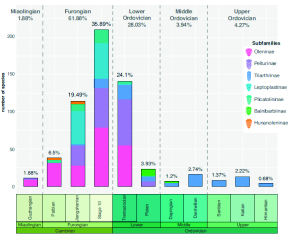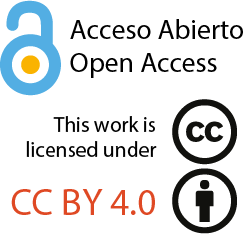The Family Olenidae (Trilobita, Arthropoda): A synopsis of its taxonomic composition, stratigraphic and paleogeographic distribution
La Familia Olenidae (Trilobita, Arthropoda): Sinópsis de su composición taxonómica, distribución estratigráfica y paleogeográfica
DOI:
https://doi.org/10.5710/PEAPA/21.10.2024.505Keywords:
Olenidae, Descriptive statistics, Stratigraphic distribution, Paleogeographic distribution, Cambrian, OrdovicianAbstract
This paper provides a list of all named species in the family Olenidae, along with their geographic and stratigraphic records. It also discusses each of the valid genera in the family and describes the composition of the entire group and its subfamilies in terms of species and generic richness across different periods and geographical areas. The family encompasses 64 genera and 394 species, primarily concentrated in the subfamilies Oleninae and Pelturinae (65.63% of the genera and 58.12% of the species). The Olenidae was first documented during the Guzhangian in Baltica, and subsequently, its range expanded globally to Eastern Gondwana (Australia), South China, and Siberia. The Furongian saw a peak in species diversity (61.88% of the total) and widespread distribution. During the Tremadocian, the number of species declined, yet the geographic range persisted, and this decrease continued for the rest of the Ordovician. Although the family is cosmopolitan, Baltica and Avalonia host almost half of the records (46.71%). Challenges in olenid systematics include species lacking proper illustrations and/or lost type materials, poorly diagnosed genera, and potential polyphyletic larger families. The study emphasizes the importance of precise species and genus delimitation. The dataset presented serves as an initial step in achieving a clearer phylogenetic classification of the family Olenidae.
References
Adrain, J. M. (2013). A synopsis of Ordovician trilobite distribution and diversity. Geological Society Memoir, 38(1), 297–336. https://doi.org/10.1144/M38.20
Angelin, N. P. (1854). Palaeontologica scandinavica, Crustacea Formationis Transitionis pars II. Academiae Regiae Scientarium Sueccanae (Holmiae).
Balseiro, D., Waisfeld, B. G., & Vaccari, N. E. (2011). Paleoecological dynamics of Furongian (late Cambrian) trilobite-dominated communities from northwestern Argentina. Palaios, 26(8), 484–499. https://doi.org/10.2110/palo.2010.p10-152r
Bao, J. -S. & Jago, J. B. (2000). Late Late Cambrian trilobites from near Birch Inlet, south-western Tasmania. Palaeontology, 43(5), 881–917. https://doi.org/10.1111/1475-4983.00154
Beecher, C. E. (1896). The morphology of Triarthrus. Geological Magazine, 3(5), 193–197. https://doi.org/10.1017/S001675680013081X
Bird, C. & Clarkson, E. (2003). Observations on the ontogeny of the upper Cambrian trilobite Peltura scarabaeoides westergaardi Henningsmoen, 1957. GFF, 125(4), 177–190. https://doi.org/10.1080/11035890301254177
Brongniart, A. (1822). Histoire naturelle des crustaces fossiles sous les rapports zoologique et geologique, savoir les trilobites. Chez F.-G. Levrault, Libraire.
Brøgger, W. C. (1882). Die Silurisćhen Etagen 2 und 3 im Kristianiagebiet und auf Eker, ihre Gliederung, Fossilien, Schichtenstörungen und Contactmetamorphosen. A. W. Brøgger.
Burmeister, H. (1843). Die Organisation der Trilobiten, aus ihren lebenden Verwandten entwickelt: nebst einer systematischen Übersicht aller zeither beschriebenen Arten. De Gruyter, Incorporated.
Chatterton, B. D. E. & Gibb, S. (2016). Furongian (upper Cambrian) trilobites of the McKay Group, Bull River Valley, Near Cranbrook, Southeastern British Columbia, Canada. Palaeontographica Canadiana, 35, 1–275.
Chernysheva, N. E. (1950). [New Middle Cambrian trilobites from eastern Siberia]. Trudy Vsesoyuznogo Nauchno-Issledovatel’skogo Geologicheskogo Instituta (VSEGEI), palaeontology series, 1, 67–77, pl. 1. [in Russian]
Cisne, J. L. (1975). Anatomy of Triarthrus and the relationships of the Trilobita. Fossils and Strata, 4, 45–63.
Cisne, J. L. (1981). Triarthrus eatoni (Trilobita); anatomy of its exoskeletal, skeletomuscular, and digestive systems. Palaeontographica Americana, 9, 95–142.
Clark, T. H. (1924). The paleontology of the Beekmantown Series at Levis, Quebec. Bulletins of American Paleontology, 10(41), 1–134.
Clarkson, E. N. K. & Ahlberg, P. (2002). Ontogeny and structure of a new, miniaturised and spiny olenid trilobite from southern Sweden. Palaeontology, 45(1), 1–22. https://doi.org/10.1111/1475-4983.00224
Clarkson, E. N. K., Ahlgren, J., & Taylor, C. M. (2004). Ontogeny, structure and functional morphology of some spiny Ctenopyge species (Trilobita) from the upper Cambrian of Vätergötland, Sweden. Transactions of the Royal Society of Edinburgh, Earth Sciences, 94(2), 115–143. https://doi.org/10.1017/s0263593300000559
Clarkson, E. N. K., Taylor, C. M., & Ahlberg, P. (1997). Ontogeny of the trilobite Parabolina spinulosa (Wahlenberg, 1818) from the upper Cambrian Alum Shales of Sweden. Transactions of the Royal Society of Edinburgh: Earth Sciences, 88, 69–89. https://doi:10.1017/S0263593300006842
Cocks, L. R. M. & Torsvik, T. H. (2002). Earth geography from 500 to 400 million years ago: a faunal and palaeomagnetic review. Journal of the Geological Society, 159(6), 631–644. https://doi.org/10.1144/0016-764901-118
Cocks, L. R. M. & Torsvik, T. H. (2021). Ordovician palaeogeography and climate change. Gondwana Research, 100, 53–72. https://doi.org/10.1016/j.gr.2020.09.008
Cooper, B. N. (1953). Trilobites from the lower Champlainian formations of the Appalachian Valley. Memoire of the Geological Society of America, 55, 1–69.
Cossman, M. (1902). Rectification de nomenclature. Revue Critique de Paléozoologie, 6, 52.
Dalman, J. W. (1827). Om Palaeaderna eller de så kallade Trilobiterna. Kongliga Svenska Vetenskaps-Akademiens Handlingar, 1826(2), 113–294.
Egorova, L. I., Lomovitskaya, M. P., Poletaeva, O. K., & Sivov, A. G. (1955). Klass Trilobita, Trilobites. In L. L. Khalfin (Ed.), Atlas of Index Forms of the Fossil Fauna and Flora of Western Siberia, Vol. 1. (pp. 102–179). Gosgeoltexizdat.
Fortey, R. A. (1974). The Ordovician Trilobites of Spitsbergen l. Olenidae. Norsk Polarinstitutt Skrifter, 160, 1–129.
Fortey, R. A. (1975). Early Ordovician trilobite communities. Fossils and Strata, 41(1), 339–360.
Fortey, R. A. (1989). There are extinctions and extinctions: examples from the Lower Palaeozoic. Philosophical Transactions of the Royal Society of London. B, Biological Sciences, 325(1228), 327–355. https://doi.org/10.1098/rstb.1989.0092
Fortey, R. A. (1999). Olenid trilobites as chemoautotrophic symbionts. Acta Universitatis Carolinae, Geologica, 43, 355–356.
Fortey, R. A. (2000). Olenid trilobites: The oldest known chemoautotrophic symbionts? Proceedings of the National Academy of Sciences, 97, 6574–6578. https://doi.org/10.1073/pnas.97.12.6574
Green, J. (1832). A monograph of the trilobites of North America: with coloured models of the species. J. Brano.
Harrington, H. J. & Leanza, A. F. (1943). La fáunula del Tremadociano inferior de Salitre (Bolivia). Revista Del Museo de La Plata (Nueva Serie), 2, 343–356.
Harrington, H. J. & Leanza, A. F. (1952). La clasificación de los “Olenidae” y de los “Ceratopygidae” (Trilobita). Revista de La Asociación Geológica Argentina, 7(3), 190–206.
Harrington, H. J. & Leanza, A. F. (1957). Ordovician trilobites of Argentina. Department of Geology, University of Kansas, Special Publication, 1, 1–276.
Hegna, T. A., Martin, M. J., & Darroch, S. A. (2017). Pyritized in situ trilobite eggs from the Ordovician of New York (Lorraine Group): implications for trilobite reproductive biology. Geology, 45(3), 199–202. https://doi.org/10.1130/G38773.1
Henningsmoen, G. (1957). The trilobite family Olenidae, with description of Norwegian material and remarks on the Olenid and Tremadocian series. Skrifter Utgitt av det Norske Videnskaps-Akademi i Oslo, I, Matematisk-naturvidenskapelig Klasse, 1957(1), 1–303.
Hopkins, M. J. (2019). Phylogenetic analysis and revision of the trilobite subfamily Balnibarbiinae (Olenidae). American Museum Novitates, 3928, 1–20. https://doi.org/10.1206/3928.1
Høyberget, M. & Bruton, D. L. (2012). Revision of the trilobite genus Sphaerophthalmus and relatives from the Furongian (Cambrian) Alum Shale Formation, Oslo Region, Norway. Norwegian Journal of Geology, 92, 433–450.
Jell, P. A. & Adrain, J. M. (2003). Available generic names for trilobites. Memoirs of the Queensland Museum, 48(2), 331–553.
Karim, T. S. (2008). Olenid-dominated trilobite fauna from the Shallow Bay Formation (Cow Head Group), Cambrian-Ordovician boundary interval, western Newfoundland. Canadian Journal of Earth Sciences, 45(4), 407–425. https://doi.org/10.1139/E08-008
Kaufmann, H. P. (1935). Studien auf dem Fettgebeit. Verlag Chemie.
Lazarenko, N. P. (1989). A new olenid trilobite from Novaya Zemlya. Ezhegodnik Vsesoyuznogo Paleontologicheskogo Obshchectva, 32, 288–293.
Linnarsson, G. (1880). Om försteningarne i de svenska lagren med Peltura och Sphaerophthalmus. Geologiska Föreningens i Stockholm Förhandlingar, 5(4), 132–161.
Liu, Y. (1977). A study of two genera of the late Cambrian Olenidae (Trilobita) from Taoyuan, Hunan. Acta Palaeontologica Sinica, 16(1), 120–126.
Lu, Y. & Qian, Y. (1983). Cambro-Ordovician trilobites from Eastern Guizhou. Palaeontologia Cathayana, 1, 1–105.
Lu, Y., Zhou, Z., & Zhou, Z. (1986). [New materials of Onychopyge faunas, with a discussion on the evolution of Onychopyge (Trilobita)]. Bulletin of the Nanjing Institute of Geology and Palaeontology, Academia Sinica, 7, 69–126. [in Chinese]
Ludvigsen, R. (1982). The Cambrian-Ordovician boundary in the western District of Mackenzie, Canada. In M. G. Bassett & W. T. Dean (Eds.), The Cambrian-Ordovician boundary: sections, fossil distributions, and correlations (pp. 141–153). National Museum of Wales, Geological Series No3.
Ludvigsen, R. & Tuffnell, P. A. (1983). A revision of the Ordovician olenid trilobite Triarthrus Green. Geological Magazine, 120, 567–577.
Ludvigsen, R. & Tuffnell, P. A. (1994). The last olenacean trilobite: Triarthrus in the Whitby Formation (Upper Ordovician) of southern Ontario. New York State Museum Bulletin, 481, 183–212.
Mángano, M. G., Buatois, L. A., Waisfeld, B. G., Muñoz, D. F., Vaccari, N. E., & Astini, R. A. (2021). Were all trilobites fully marine? Trilobite expansion into brackish water during the early Palaeozoic. Proceedings of the Royal Society B: Biological Sciences, 288(1944), 20202263. https://doi.org/10.1098/rspb.2020.2263
Månsson, K. & Clarkson, E. N. K. (2012). Ontogeny of the Upper Cambrian (Furongian) Olenid trilobite Protopeltura aciculate (Angelin, 1854) from Skåne and Västergötland, Sweden. Palaeontology, 55(4), 887–901. https://doi.org/10.1111/j.1475-4983.2012.01162.x
Månsson, K. & Clarkson, E. N. K. (2016). Early ontogeny of the Furongian (Cambrian) olenid trilobites Sphaerophthalmus alatus (Boeck, 1838) and Ctenopyge (Mesoctenopyge) tumida Westergård, 1922 from Bornholm, Denmark. Earth and Environmental Science Transactions of The Royal Society of Edinburgh, 106(3), 171–183. https://doi.org/10.1017/S1755691016000086
Månsson, K. & Clarkson, E. N. K. (2018). A revised ontogeny of the early Ordovician trilobite Leptoplastides salteri (Callaway, 1877). Earth and Environmental Science Transactions of the Royal Society of Edinburgh, 111(1), 1–16. https://doi.org/10.1017/S1755691018000841
Monti, D. S. & Confalonieri, V. A. (2013). Phylogenetic analysis of the late Cambrian-early Ordovician genus Parabolinella Brøgger (Trilobita, Olenidae). Geological Journal, 48(2-3), 156–169. https://doi.org/10.1002/gj.1343
Monti, D. S. & Confalonieri, V. A. (2019). First cladistic analysis of the trilobite family Olenidae from the Furongian and Ordovician. Lethaia, 52(3), 304–322. https://doi.org/10.1111/let.12313
Monti, D. S., Tortello, M. F., & Confalonieri, V. A. (2022). A phylogenetic approach to the study of the evolution of Hypermecaspididae (Olenida, Trilobita). Papers in Palaeontology, 8(3), e1433. https://doi.org/10.1002/spp2.1433
Moore, R. C. (1959). Treatise on Invertebrate Paleontology, Part O, Arthropoda 1. Geological Society of America and University of Chicago Press.
Murchison, R. I. (1859). Siluria: A history of the oldest fossiliferous rocks and their foundations; with a brief sketch of the distribution of gold over the earth. J. Murray.
Nielsen, A. T. & Andersen, L. F. (2021). Furongian (upper Cambrian) trilobites and agnostoids from the Alum Shale Formation of Bornholm, Denmark: revised taxonomy and biostratigraphy. Bulletin of the Geological Society of Denmark, 69, 123–213. https://doi.org/10.37570/bgsd-2021-69-08
Nielsen, A. T., Høyberget, M., & Ahlberg, P. (2020). The Furongian (upper Cambrian) alum shale of Scandinavia: Revision of zonation. Lethaia, 53(4), 462–485. https://doi.org/10.1111/let.12370
Ng, R. Y. (2019). The Cambrian-Ordovician trilobite genus Clelandia, with phylogeny and morphology of new and revised species [Unpublished Ms. Thesis] University of Iowa. Retrieved from https://doi.org/10.17077/etd.5fda-79p2
Ng, R. Y. & Adrain, J. M. (2018). Phylogeny and morphology of the Cambrian-Ordovician trilobite genus Clelandia with new and revised species. Abstracts with programs of the Geological Society of America 2018 annual meeting & exposition, Geological Society of America, 50(6), EID: 324590.
Nikolaisen, F. & Henningsmoen, G. (1985). Upper Cambrian and lower Tremadoc olenid trilobites form the Digermul peninsula, Finnmark, northern Norway. Norges Geologiske Undersokelse, Bulletin, 400, 1–49.
Peng, S., Babcock, L. E., & Lin, H. (2004). Polymerid trilobites from the Cambrian of northwestern Hunan, China (Vol. 1). Science Press.
Petrunina, Z. E. (2002). New trilobite taxa of the family Olenidae Burmeister 1843 from the Cambrian-Ordovician boundary beds of the west Siberia. News of Paleontology and Stratigraphy, Supplement Geology and Geophysics, 43(5), 81–111.
Poulsen, C. (1960). Fossils from the late Middle Cambrian Bolaspidella Zone of Mendoza, Argentina. Matematisk-fysiske Meddelelser, Det Kongelige Danske Videnskabernes Selskab, 32(11), 1–42.
Přibyl, A. & Vaněk, J. (1980). Ordovician trilobites of Bolivia. Rozpravy Ceskoslovenské Akademie, 90, 1–90.
Qian, Y. (1961). [Cambrian trilobites from Sandu and Duyun, southern Kweichow]. Acta Palaeontologica Sinica, 9, 91–129, pls. 1–5. [in Chinese]
R Core Team. (2022). R: A language and environment for statistical computing. R Foundation for Statistical Computing, Vienna, Austria. https://www.R-project.org/
Rasmussen, B. W., Rasmussen, J. A., & Nielsen, A. T. (2017). Biostratigraphy of the Furongian (upper Cambrian) Alum Shale Formation at Degerhamn, Öland, Sweden. GFF, 139(2), 92–118. https://doi.org/10.1080/11035897.2016.1276099
Raw, F. (1908) The trilobite fauna of the Shineton Shales. Reports of the British Association for the advancement of Science, 1907, 511–513.
Raymond, P. E. (1924). No. 4.-New Upper Cambrian and Lower Ordovician trilobites from Vermont. Proceedings of the Boston Society of Natural History, 37, 1–389.
Robison, R. A. & Pantoja-Alor, J. (1968). Tremadocian trilobites from the Nochixtlán region, Oaxaca, Mexico. Journal of Paleontology, 42(3), 767–800.
Rusconi, C. (1951). Trilobitas cámbricos del Cerro Pelado (Mendoza). Boletín Paleontológico de Buenos Aires, 24, 1–4.
Rusconi, C. (1955). Más fósiles cámbricos y ordovícicos de San Isidro, Mendoza. Boletín Paleontológico de Buenos Aires, 31, 1–4.
Salter, J. W. (1849). Figures and descriptions illustrative of British organic remains, decade 2. Green and Longmans.
Serra, F., Balseiro, D., Vaucher, R., & Waisfeld, B. G. (2021). Structure of trilobite communities along a delta-marine gradient (lower Ordovician; Northwestern Argentina). Palaios, 36(2), 39–52. https://doi.org/10.2110/palo.2020.013
Shaw, A. B. (1951). The paleontology of northwestern Vermont. I. New late Cambrian trilobites. Journal of Paleontology, 25(1), 97–114. http://www.jstor.org/stable/1299834
Terfelt, F. (2006). Review of uppermost Furongian trilobites from Scania, southern Sweden, based on type material. Palaeontology, 49(6), 1339–1355. https://doi.org/10.1111/j.1475-4983.2006.00600.x
Terfelt, F., Eriksson, M. E., Ahlberg, P., & Babcock, L. E. (2008). Furongian Series (Cambrian) biostratigraphy of Scandinavia–a revision. Norwegian Journal of Geology/Norsk Geologisk Forening, 88(1), 73–87.
The Paleobiology Database. Ocurrence data, Olenidae. Retrieved July 10, 2024 from www.paleobiodb.org
Torsvik, T. H. & Cocks, L. R. M. (2016). Cambrian. In T. H. Torsvik & L. R. M. Cocks (Eds), Earth History and Palaeogeography (pp. 85–100). Cambridge University Press. https://doi.org/10.1017/9781316225523.006
Tortello, M. F. (2017). Trilobites from the Lejopyge laevigata Zone (Guzhangian; upper middle Cambrian) of the San Isidro area, Mendoza, Argentina. Ameghiniana, 54(4), 465–474. https://doi.org/10.5710/AMGH.16.01.2017.3060
Tortello, M. F. & Esteban, S. B. (2003). Lower Ordovician stratigraphy and trilobite faunas from the southern Famatina Range, La Rioja, Argentina. Special Papers in Palaeontology, 70, 213–240.
Troedsson, G. T. (1951). Hedinaspis, new name for Hedinia Troedsson non Navás. Geologiska Föreningens i Stockholm Förhandlingar, 73, 1–695.
Walcott, C. D. (1924). Cambrian geology and paleontology. Cambrian and Lower Ozarkian trilobites. Smithsonian Miscellaneous Collections, 75, 53–60.
Walcott, C. D. (1925). Cambrian geology and paleontology. Cambrian and Ozarkian trilobites. Smithsonian Miscellaneous Colletions, 75, 61–146.
Westergård, A. H. (1922). Sveriges Olenidskiffer. Sveriges Geologiska Undersokning. Serie Ca., 18, 1–205.
Westergård, A. H. (1948). Non-agnostidean Trilobites of the Middle Cambrian of Sweden. Sveriges Geologiska Undersökning Series C, 498, 1–32.
Wickham, H. (2016). ggplot2: Elegant Graphics for Data Analysis. Springer-Verlag New York. https://ggplot2.tidyverse.org
Zhang, W. & Fan, J. (1960). Ordovician and Silurian trilobites of the Chilian Mountains. In T. Yin (Ed.), Geological Gazetter of the Chilian Mountains (pp. 83–148). Science Press.
Zhou, Z. & Zhen, Y. (2008). Trilobite record of China. Science Press.
Zhu, Z. (1960). [Cambrian trilobites from the southern slopes of the Chilian Mountains]. Geological Gazetteer of Chilian Mountains, 4(1), 53–68. [in Chinese]
Zhu, Z. (1965). [Some Middle Cambrian trilobites from Huzhu, Tsinghai (=Qinghai)]. Acta Palaentologica Sinica, 13(1), 133–149. [in Chinese]
Żylińska, A. (2001). Late Cambrian trilobites from the Holy Cross Mountains, central Poland. Acta Geologica Polonica, 51(4), 333–383.

Additional Files
Published
Issue
Section
License
Copyright (c) 2025 Daniela Soledad Monti

This work is licensed under a Creative Commons Attribution-NoDerivatives 4.0 International License.
Authors retain copyright and grant the journal right of first publication with the work simultaneously licensed under a Atribución/Reconocimiento 4.0 Internacional that allows others to share the work with an acknowledgement of the work's authorship and initial publication in this journal.















